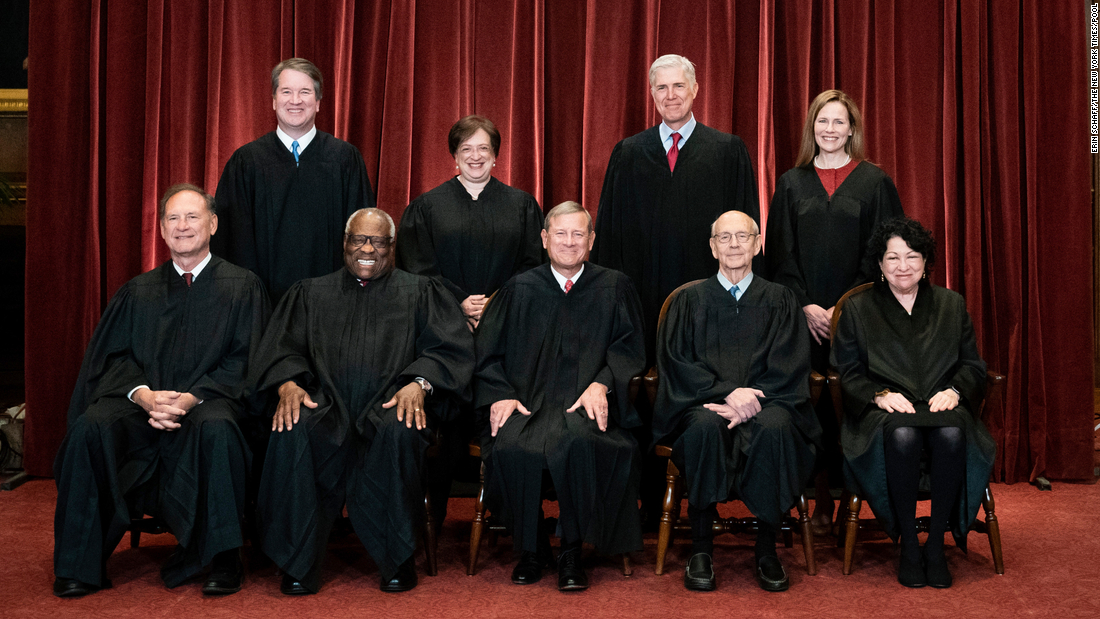
What happens if the Supreme Court throws out Roe v. Wade?

A version of this story appeared in CNN’s What Matters newsletter. To get it in your inbox, sign up for free here.
(CNN)In some alternate universe, Supreme Court Justice Ruth Bader Ginsburg retired during the Obama presidency and Democrats were able to push through a successor to the conservative Justice Antonin Scalia.
In that universe, nobody is talking about an end to nearly 50 years of nationwide access to abortion rights.
But here we are.
There’s a chance abortion could be illegal in much of the country in the near future since Mississippi asked the court this week to overturn Roe v. Wade.
What happens if the court overturns Roe v. Wade? Mississippi is one area where availability of legal abortion would decline precipitously if the ruling is overturned. Abortion access would not simply end nationwide, but rather state laws would take over.
A New York Times analysis published in May suggested access would be most affected in the American South and Midwest. Abortion could become illegal in 22 states and remain largely unchanged in 28.
Ten states have passed laws that would trigger in the event Roe is overturned and automatically ban all abortions. They include both Dakotas, Idaho and Utah, and a band of states that stretches from Kentucky down to Louisiana. And some states still have laws on the books that ban abortion that would presumably revive if the case is overturned, according to the Guttmacher institute.
What brings us to this moment is not a mass movement of Americans, but rather two unexpected Supreme Court deaths, some extraordinary maneuvering by then-Senate Majority Leader Mitch McConnell and a legal challenge by Mississippi.
The Supreme Court can influence elections. Court nominations have featured to different degrees in each of the two most recent presidential elections, and in both cases the voters most motivated by the issue were supporters of the Republican candidate.
In 2016, the court was a motivating factor. There was an open seat and ideological sway of the court was in play after Scalia died. Republicans had blocked President Barack Obama’s nomination of Merrick Garland and 21% of voters said Supreme Court appointments were the most important factor in their votes, according to CNN’s exit polls. A majority of those picked Donald Trump. The vote was more closely split between Trump and Democrat Hillary Clinton among those who said Supreme Court appointments were not the most important thing.
In 2020, the battle over the court had been won. Ginsburg had died and Barrett had solidified the new 6-3 conservative majority. A smaller portion of voters in the general election, 13%, said Supreme Court appointments were the most important factor and they more narrowly sided with Trump over Joe Biden, according to CNN’s exit polls.
How will the court feature next? With a safe conservative majority and without an open seat or a recently confirmed new justice, it is possible the issue of court appointments could lose some of its potency for Republicans, who now have the conservative court they long sought.
Democrats, meanwhile, have made an appeal to female voters central to their platform and pitch, and a court decision that ends nationwide access to abortion services would certainly reenergize that particular issue for them, although Justice Stephen Breyer’s wish is that court appointments were less political, not more so.
Tough nuts.
Politics has everything to do with it and that will continue to be the case.
Now-Senate Minority Leader McConnell has said it’s “highly unlikely” that Republicans would allow a Biden Supreme Court nominee to advance if they retake the majority in 2022. That is a hard no as long as he can keep his party unified.
The American public in general doesn’t want Roe overturned. A recent CNN review of polling on the issue included recent national polls that showed between 61% and 69% of Americans did not want to see the precedent ended. There’s been steady majority support across the country for legal abortion since the mid-’90s.
The story in individual states is different. A Pew survey in 2014 suggested that more than 70% of people in Massachusetts supported access to abortion in all or most cases, but less than 40% of people in Mississippi felt the same way.
Democrats have moved more than Republicans. The partisan divide over abortion has grown in the past 15 years, according to CNN’s Ariel Edwards-Levy, who wrote in May that Democrats are moving more than Republicans on the issue:
What has changed is the size of the partisan divide on the issue. Abortion has become increasingly polarized over the past 15 years, in large part because of growing support for legalized abortion among Democrats. Between 2007 and 2021, according to Pew, the share of Democrats and Democratic-leaning independents supporting broadly legalized abortion rose 17 percentage points, to 80%, while the share of Republicans and Republican-leaners saying the same dipped by 4 points, falling to 35%.
Should Breyer retire? When Scalia died at 79 in 2016, Democrats were appalled by Republicans’ ability to block Obama’s nomination and saw the possibility of a new majority of liberal justices vanish.
When Ginsburg died at 87 in 2020, they were shocked at Republicans’ ability to jam through Trump’s nominee and create what could be a long generation of a strong conservative majority.
Proposals to expand the court and dilute the power of the conservative majority are doomed in a Senate beholden to the filibuster, although Biden has appointed a commission to study the idea. That leaves angsty liberals to be frustrated with Breyer, who won’t throw in the towel and make room for a younger, perhaps fitter justice.
No time line for Breyer. He has not been plagued by cancer for years like Ginsburg was, and he told CNN’s Joan Biskupic that at 82 — energetic, jogging, meditating and about to turn 83 — he’s happy now to be the senior liberal on the Supreme Court and has no time line to retire.
Wearing shorts and sandals at his vacation home in New Hampshire, he opened up to Biskupic about his satisfaction at leading the liberal justices, albeit a smaller bloc, in conference on key cases and dodged any sort of time line for his departure.

Since Supreme Court justices have lifetime appointments, an anomaly in democratic societies, he can pick his retirement date. But he can’t pick the president or the Senate majority. And who knows when Democrats will have the White House and the Senate majority again.
“Stephen Breyer is playing checkers and Mitch McConnell is playing chess. I mean the — the idea that he is somehow preserving the court by pretending that politics has nothing to do with the Supreme Court, you know, is just delusional,” fumed Jeffrey Toobin, the CNN legal analyst, reacting to Biskupic’s published interview earlier this month on CNN’s “New Day.”
“This is the kind of absence of strategic thinking that has done in Democrats on the Supreme Court and we’ll see if it continues here,” he said.
What are Breyer’s windows? Really, the only timeline that matters at the moment is the one that ends in January 2023, when the next Congress convenes and Republicans could take control of the Senate.
If they do, Breyer would have to wait until January 2025, when he’ll be 86, if he wants the possibility of a Democratic president picking his successor.
If a Republican wins in 2024, he’d have to wait until January 2029, when he’ll be 90. And so on.
Clarence Thomas, who has been on the court longer than Breyer, is just 73. Toobin writes for CNN that in the new conservative majority, Thomas is taking on a leadership role after being sidelined by previous courts.

“In crucial, contested cases, Chief Justice Roberts has increasingly been voting with the three remaining liberals — Stephen Breyer, Sonia Sotomayor and Elena Kagan. If Roberts continues this pattern, that means Thomas will be the senior Justice in several significant 5 to 4 cases and thus enjoy the right to assign majority opinions, including, of course, to himself,” Toobin writes.
He also points out that Thomas openly criticized Roe v. Wade in a 2020 opinion in which Roberts sided with more liberal justices.
“Our abortion precedents are grievously wrong and should be overruled,” Thomas wrote.
The Mississippi plaintiffs borrowed that language, swapping one word, for the thrust of their argument to overturn Roe.
“This Court’s abortion precedents are egregiously wrong,” they argued this week, an open invitation for Thomas and the conservative majority to do something about it.
Source: http://rss.cnn.com/~r/rss/cnn_topstories/~3/WQtnTy_n59U/index.html

















